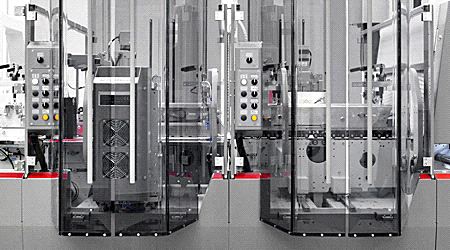Offset Printing
BOBST ACCUBRAILLE GT – Proven around the world

Friday 20. September 2013 - The embossing of drug information onto pharmaceutical packaging by the use of Braille has been mandatory throughout Europe in one form or another since 2005. In the years following the advent of this legislation, large numbers of packaging manufacturers have changed the way they emboss Braille - moving its application from the time consuming and expensive die-cutting process to a rotary system on their folder-gluers.
BOBST was at the forefront of this change of approach when it launched its ACCUBRAILLE unit in 2007 says Jacques Reymond, Head of Product Marketing Business Unit Sheet-fed. “ACCUBRAILLE led the way when it came to in-line rotary Braille embossing systems, giving pharma carton makers a faster, easier and more consistent way to get Braille onto their cartons. It was truly innovative technology at the time and now we have developed a second generation – the ACCUBRAILLE GT – which has even better performance and adds extra capabilities.”
Jacques Reymond says that the BOBST ACCUBRAILLE is now proven technology and cites an installed base of around 200 machines worldwide as proof. “There are other solutions in the market, but the feedback from users is that ACCUBRAILLE is the solution to beat. Most of these other solutions are still in their first generation. With the ACCUBRAILLE GT we’ve taken a highly valued product and made it even more productive for the user.”
Until ACCUBRAILLE became a popular solution, the majority of packaging Braille was applied using a flat-bed die-cutter and machined or etched dies. This approach not only involves a lot of skill on behalf of the operator, but is also time consuming and fraught with potential problems. For example, recycled or dry board, or board with a poor print surface, can lead the Braille to burst through, while the choice of dot shape (conical or domed) can result in problems of accelerated wear or poor definition.
Die-cutter embossed Braille requires one bespoke die for each carton on the sheet, something which may prove expensive on a multi-up pharmaceutical job, while the high tonnages needed can quickly lead to degradation of those tools, and so of the Braille dots. When applied using a die-cutter, Braille may require a separate run through a die-cutter if the text has to be placed close to the edges of the finished box.
“There is also a problem of alignment when repeating a job,” explains Jacques Reymond. “The operator has a problem in that the die-board may have grown or shrunk a little due to environmental factors. While adjustment of the lower plate can get the crease and cut lines to correspond sufficiently for good die-cutting, the fine nature of the Braille alignment may be compromised. Most users get around this by remounting their Braille counters for each run of the job, which takes extra time.”
Die-cutter embossed Braille can also affect the performance of downstream processes, specifically folder-gluers. In the feeder of the gluer line, Braille embossed cartons have a tendency to catch on each other which can cause machine stoppages, costing time and money.
Jacques Reymond says that the arrival of ACCUBRAILLE gave pharma carton makers a solution that was faster and easier than die-cutter applied Braille, delivering a more reliable level of quality, and also meant they could make their tooling cheaply, in-house.
Like its predecessor, ACCUBRAILLE GT is fitted after the Accufeed of the folder-gluer and work by bringing a pair of rotary tools to bear on the carton as it runs between them. The upper, male, tool is bespoke to the job and the lower, female, tool is universal. Compared to the setting of Braille embossing on a die-cutter, this approach is immensely quick, taking less than five minutes. Male tools for the system can be easily and inexpensively made by virtually any die making company, but BOBST also offers a Braille tooling unit. “Rather than ordering male Braille tools from a die-maker, making your own tools right alongside the folder-gluer is an idea that offers a lot of benefits,” explains Jacques Reymond. “As well as the savings generated by making the tooling in-house there is an obvious benefit in terms of tool availability since you are no longer dependent on the lead time of your supplier. It puts the entire production process 100 % under your control.”
The rotary nature of the ACCUBRAILLE process can double tool life, meaning that users suffer less waste and again lower their tooling costs. A further advantage is that, unlike on the die-cutter, Braille can be applied right up to carton edges or crease lines. “When we first launched ACCUBRAILLE it was a revelation for customers with new or existing ALPINA and MISTRAL lines.”
Extending the capabilities of the process, ACCUBRAILLE GT now offers users the ability to emboss up to eight lines of Braille at a time, as well as the opportunity to apply transverse text. “It gives carton designers huge flexibility, allowing them to offer their clients a lot of different options and to include more information,” explains Jacques Reymond, adding that the latest incarnation of the BOBST technology has also pushed achievable production speeds upwards. “We can now ensure the consistency of the Braille dots at speeds of up to 115,000 boxes an hour and the system delivers a tolerance of +/- 1mm all the times, even at these high speeds.”
Strangely, ACCUBRAILLE was not the first BOBST machine for embossing Braille. Back in 1915 Henri Bobst produced a rotary cylinder press for the Blind Institute in Lausanne, Switzerland. The machine was designed for printed sheets that were a little longer than today’s B3 format and could emboss Braille at thousands of sheets per hour. “It took the packaging industry nearly a hundred years to catch up, but today ACCUBRAILLE GT is delivering superb Braille onto cartons at high speed, and making it easy to do,” says Jacques Reymond.
